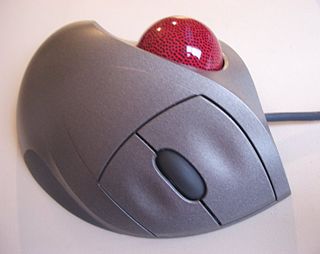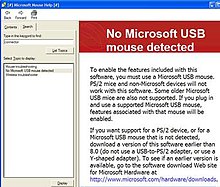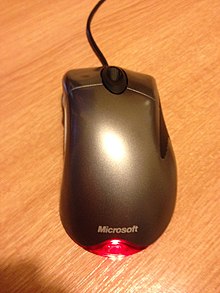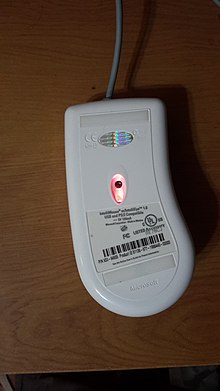
A computer mouse is a hand-held pointing device that detects two-dimensional motion relative to a surface. This motion is typically translated into the motion of the pointer on a display, which allows a smooth control of the graphical user interface of a computer.

A pointing device is a human interface device that allows a user to input spatial data to a computer. CAD systems and graphical user interfaces (GUI) allow the user to control and provide data to the computer using physical gestures by moving a hand-held mouse or similar device across the surface of the physical desktop and activating switches on the mouse. Movements of the pointing device are echoed on the screen by movements of the pointer and other visual changes. Common gestures are point and click and drag and drop.

A trackball is a pointing device consisting of a ball held by a socket containing sensors to detect a rotation of the ball about two axes—like an upside-down ball mouse with an exposed protruding ball. Users roll the ball to position the on-screen pointer, using their thumb, fingers, or the palm of the hand, while using the fingertips to press the buttons.

A scrollbar is an interaction technique or widget in which continuous text, pictures, or any other content can be scrolled in a predetermined direction on a computer display, window, or viewport so that all of the content can be viewed, even if only a fraction of the content can be seen on a device's screen at one time. It offers a solution to the problem of navigation to a known or unknown location within a two-dimensional information space. It was also known as a handle in the very first GUIs. They are present in a wide range of electronic devices including computers, graphing calculators, mobile phones, and portable media players. The user interacts with the scrollbar elements using some method of direct action, the scrollbar translates that action into scrolling commands, and the user receives feedback through a visual updating of both the scrollbar elements and the scrolled content.

An optical mouse is a computer mouse which uses a light source, typically a light-emitting diode (LED), and a light detector, such as an array of photodiodes, to detect movement relative to a surface. Variations of the optical mouse have largely replaced the older mechanical mouse design, which uses moving parts to sense motion.

A touchpad or trackpad is a type of pointing device. Its largest component is a tactile sensor: an electronic device with a flat surface, that detects the motion and position of a user's fingers, and translates them to a position on a screen, to control a pointer in a graphical user interface. Touchpads are common on laptop computers, contrasted with desktop computers, where mice are more prevalent. Trackpads are sometimes used on desktops, where desk space is scarce. Because trackpads can be made small, they can be found on personal digital assistants (PDAs) and some portable media players. Wireless touchpads are also available, as detached accessories.
Microsoft has designed and sold a variety of ergonomic keyboards for computers. The oldest is the Microsoft Natural Keyboard, released in 1994, the company's first computer keyboard. The newest models are the Sculpt Ergonomic Keyboard (2013), the Surface Ergonomic Keyboard (2016), and the Microsoft Ergonomic Keyboard (2019).

A scroll wheel is a wheel used for scrolling. The term usually refers to such wheels found on computer mice. It is often made of hard plastic with a rubbery surface, centred around an internal rotary encoder. It is usually located between the left and right mouse buttons and is positioned perpendicular to the mouse surface. Sometimes the wheel can be pressed left and right, which is actually just two additional macros buttons.

The Apple Mouse is a multi-control USB mouse manufactured by Mitsumi Electric and sold by Apple Inc. It was announced and sold for the first time on August 2, 2005, and a Bluetooth version was available from 2006 to 2009. Before the Mighty Mouse, Apple had sold only one-button mice with its computers, beginning with the Apple Lisa 22 years earlier. The Mighty Mouse supported two buttons, and a miniature trackball for scrolling.

The Microsoft Mouse is a computer mouse released by Microsoft in 1983. It is the first mouse released by the company, and it was bundled with Microsoft Word, Notepad, and an on-screen teaching tutorial for an initial price of $195.

Microsoft IntelliType is the brand driver for Microsoft's series of computer keyboards. Microsoft releases versions for both Windows and Mac OS X. It has been succeeded by Microsoft Mouse and Keyboard Center, which combines IntelliType with IntelliPoint.

IntelliMouse is a series of computer mice from Microsoft. The IntelliMouse series is credited with a number of innovations; Microsoft was among the first mouse vendors to introduce a scroll wheel, an optical mouse, and dedicated auxiliary buttons on the side of the mouse. They use IntelliPoint drivers and its main competitor through the years has been Logitech.

Apple Inc. has designed and manufactured several models of mice, trackpads and other pointing devices, primarily for use with Macintosh computers. Over the years, Apple has maintained a distinct form and function with its mice that reflect their design languages of that time. Apple's current external pointing devices are the Magic Mouse 2 and Magic Trackpad 2.

A mouse button is an electric switch on a computer mouse which can be pressed (“clicked”) to select or interact with an element of a graphical user interface. Mouse buttons are most commonly implemented as miniature snap-action switches.
HIDPoint is proprietary Linux software for USB Keyboards and Mice. Currently it supports most Logitech keyboards and mice. It runs on many Linux distributions such as RHEL, SUSE, Ubuntu and Fedora. HIDPoint has been designed to give users using USB Mice and Keyboards the same experience they get when using these devices on Microsoft Windows.

A computer keyboard is a peripheral input device modeled after the typewriter keyboard which uses an arrangement of buttons or keys to act as mechanical levers or electronic switches. Replacing early punched cards and paper tape technology, interaction via teleprinter-style keyboards have been the main input method for computers since the 1970s, supplemented by the computer mouse since the 1980s.

Eric Michelman, a graduate from MIT, is credited with inventing the now commonplace computer input device known as the scroll wheel. Scroll wheels are most often located between the left and right-click buttons on modern computer mice.

In computing, an input device is a piece of equipment used to provide data and control signals to an information processing system, such as a computer or information appliance. Examples of input devices include keyboards, mouse, scanners, cameras, joysticks, and microphones.
Microsoft Mouse and Keyboard Center is software that provides drivers for recent Microsoft mice and keyboards. It allows the user to set up and configure both mice and keyboards from within the same program.

















